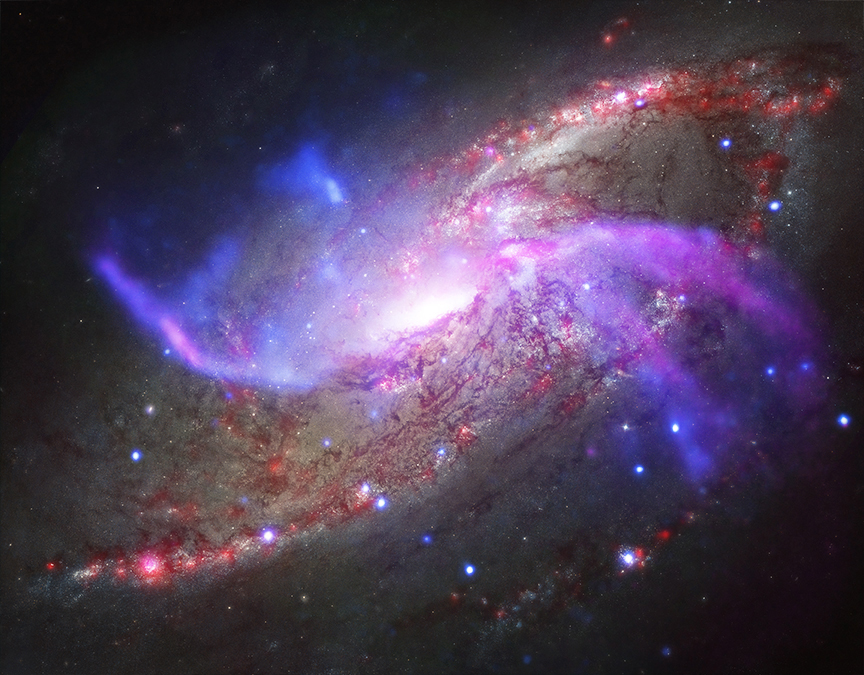Galaxy's Huge Black Hole Puts on Spectacular Fireworks Show (Video)

The supermassive black hole at the center of a far-off galaxy is putting on a fireworks display of cosmic proportions.
Scientists captured the brilliant display in new images and a video tour of the spiral galaxy Messier 106 (also called NGC 4258). An amazing composite picture was created by combining data from three NASA telescopes and a National Science Foundation (NSF) telescope trained on Messier 106, which is about 23 million light-years away.
While the galaxy is spiral in shape, like the Milky Way, Messier 106 has two extra swirling armsthat glow in X-ray, optical and radio light. These features are called anomalous arms and intersect the galaxy at an angle instead of aligning with the main galactic disk. [See Amazing Images of the X-Ray Universe]
The combination of data from multiple telescopes revealed that the swirling arms of Messier 106 are streams of shock waves and superheated gas. The NSF telescope picked up radio waves from high-energy particles streaming from the supermassive black hole at the center of the galaxy. Infrared light data gathered by NASA's Spitzer Space Telescope shows that these bursts of particles create shock waves, similar to sonic booms, when they strike the main disk of the galaxy. The shock waves heat up huge pockets of hydrogen gas to thousands of degrees.
The new composite image released by NASA earlier this month shows X-rays seen by NASA's Chandra X-Ray Observatory in blue; radio waves captured by the NSF's Karl Janksy Very Large Array are shown in purple; visible light data from the Hubble telescope can be seen in yellow and blue; and infrared light from the Spitzer telescope in red.
Chandra's X-ray images reveal huge, superheated gas bubbles above and below the plane of the galaxy. This suggests that much of the gas inside the galaxy is heated to millions of degrees and then rides along the shock waves streaming from the black hole to the outer regions of the galaxy.
Researchers predict all the gas from the galaxy will be cast out within the next 300 million years unless it is somehow replenished. Since most of the gas is already gone, less gas is available for star formation. Researchers using Spitzer estimate that stars are forming in Messier 106 almost 10 times more slowly than they are in the Milky Way. The black hole at the center of Messier 106 is about 10 times larger than the black hole in the Milky Way and is sucking in material much more quickly.
Get the Space.com Newsletter
Breaking space news, the latest updates on rocket launches, skywatching events and more!
Researchers hope to learn more about how the black hole is influencing the galaxy. The results of the new galaxy study were published June 20 in The Astrophysical Journal Letters.
Follow Kelly Dickerson on Twitter. Follow us @Spacedotcom, Facebook or Google+. Originally published on Space.com.
Join our Space Forums to keep talking space on the latest missions, night sky and more! And if you have a news tip, correction or comment, let us know at: community@space.com.

Kelly Dickerson is a staff writer for Live Science and Space.com. She regularly writes about physics, astronomy and environmental issues, as well as general science topics. Kelly is working on a Master of Arts degree at the City University of New York Graduate School of Journalism, and has a Bachelor of Science degree and Bachelor of Arts degree from Berry College. Kelly was a competitive swimmer for 13 years, and dabbles in skimboarding and long-distance running.









